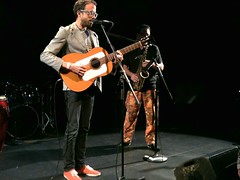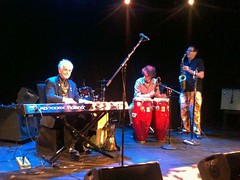An eclectic group of musicians – including Gordon Gano belting out his Violent Femmes classic “Blister in the Sun” – performed last night at a benefit to “put a stop to this destructive, environmentally calamitous process that’s destroying the city we all love.” At least, that’s how the evening’s M.C., Mark Crispin Miller of Faculty Against the Sexton Plan, put it shortly before announcing that Susan Sarandon and Matthew Broderick were among those who pledged money to a lawsuit against N.Y.U.’s expansion plans.
The idea behind the “Save the Village” concert at Le Poisson Rouge, Mr. Miller told an audience of about 200, was to show that the Village still rocks – even if “N.Y.U. does not rock. N.Y.U. rolls. It rolls its students; it rolls its faculty; it rolled the City Council. We’ve got to stop this.”
To that end, songstress Janine Nichols kicked off the night by cooing “This Land Is Your Land” with John Kruth on sitar. (It was that kind of evening: bongos, banjos, cowbells, canastas, and, yes, even scatting. At times the Greenwich Village club resembled a genuine Beat coffee shop.)
Noise rocker Thurston Moore of Sonic Youth got right into it with composer and saxophonist John Zorn. The duo launched into a cacophany of discordant free jazz that had all the abrasiveness of, well, jackhammering south of Washington Square Park.
Mr. Zorn, dressed in his signature camouflage pants and a t-shirt advertising his East Village venue The Stone, returned to the stage with a mellower, bluesier sound to back the nattily dressed singer-songwriter Jesse Harris; then he packed up and was on his way out the door when David Amram unexpectedly summoned him back to the stage, to Mr. Zorn’s befuddlement and everyone else’s amusement.
The saxophonist had no trouble catching on to Mr. Amram’s opening number, a waltz the composer had written for Arthur Miller’s play “After the Fall.” (The playwright, explained Mr. Amram, “loved the university as much as we all do.”)
While most musicians didn’t explicitly speak out against N.Y.U. 2031, Mr. Amram, a Greenwich Village resident since 1955 (and a veteran of the East Village, as well), minced no words as he compared the expansion plan to “King Kong trying to destroy New York, only he didn’t succeed, and Doctor Kevorkian trying to tell us that we’re supposed to commit suicide by having an entire neighborhood decimated.” The expansion would be an unwise business decision, he said, because future alumnae wouldn’t give their money to the school after watching “one of the greatest universities in the world shame themselves with this irresponsible and disgusting act.”
Next up was Gary Lucas, who, between a couple of hard-driving acoustic guitar instrumentals, told the audience, “I’ve lived in the West Village for 35 years, and I love the East Village, too. I tell you, I’m going to move out as soon as Yonah Schimmel’s and Katz’s Deli are devoured by N.Y.U. – that’ll be time to go.”
Then came some covers: John Kelly did Donovan’s “To Try For the Sun” because it reminded him of coming to Greenwich Village as a young New Jersey native in the 1970s, and Ms. Nichols, returning to the stage with the band TriBeCaStan, performed Harry Nilsson’s “Pretty Soon There’ll Be Nothing Left For Everybody,” at one point inserting the words “student body” into the refrain.
By the time TriBeCaStan, the genre-bending jazz and world-music outfit, took the stage, the crowd – which included many photographers, one of whom was scolded and flipped off by Mr. Zorn – had thinned out to about 50. Too bad for those who left: they missed an amusing Zappa-esque cover of Sheb Wooley’s 1958 novelty song, “The Purple People Eater”: “I said, ‘Mr. Purple People Eater, please don’t eat me,’” intoned Mr. Kruth, “Please don’t eat my street; please don’t eat all the cherry trees that I love so much every spring.’”
Sitting in with TriBeCaStan, and playing a mean fiddle, was Gordon Gano, lead singer of Violent Femmes. When he was introduced to relative silence, he told the crowd, “You don’t know me now, but if you’re here till the end I think you might go, ‘Oh, he’s that guy?’”
Recognition dawned for some when he drawled the Violent Femmes song “Country Death Song,” and it came in full force when he ended the night with the band’s 1983 hit, “Blister in the Sun.”
“I played this song in the ’80s in a bunch of places in the Village,” he told the crowd, “and those places aren’t here anymore, but this place is.”






